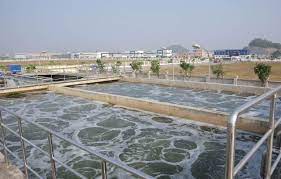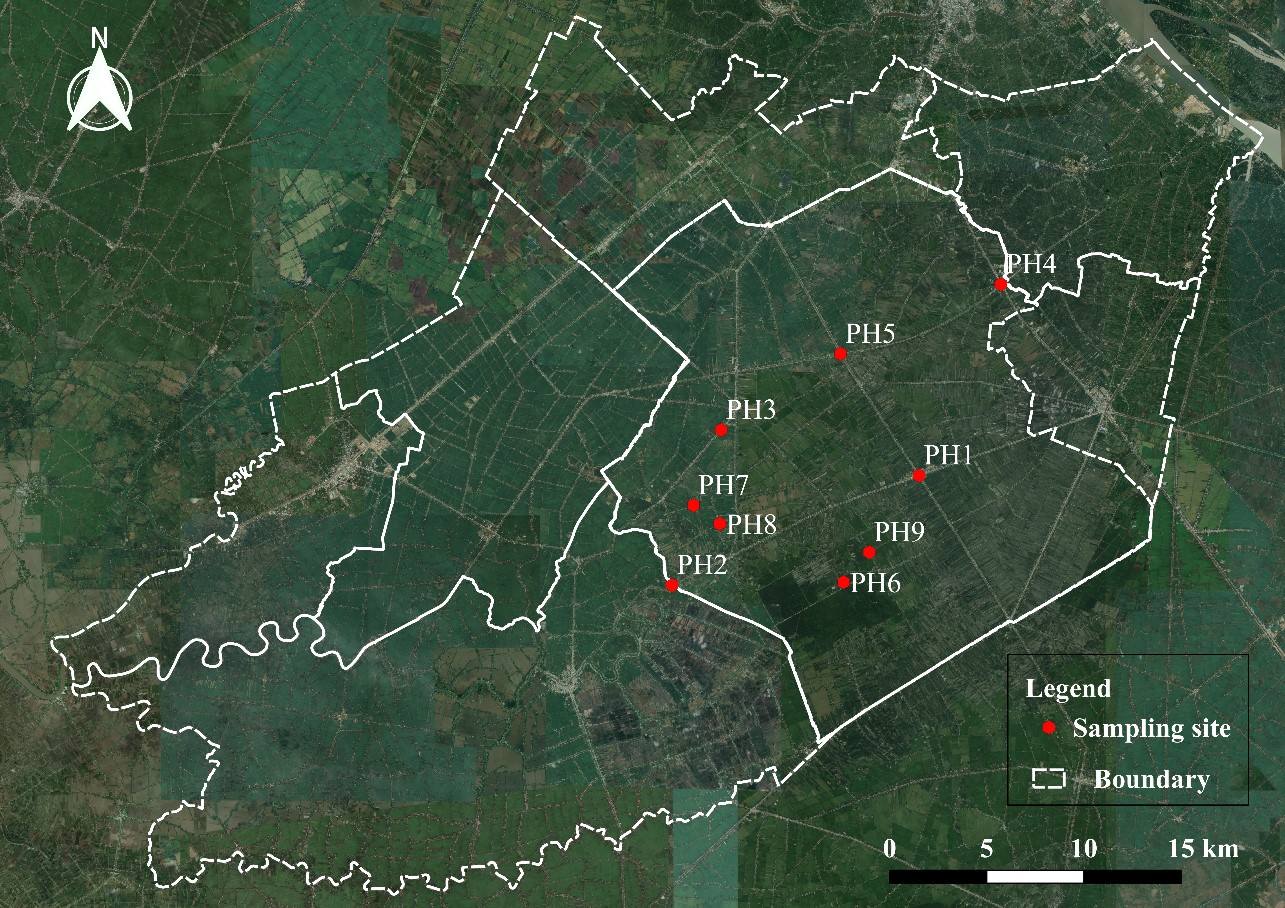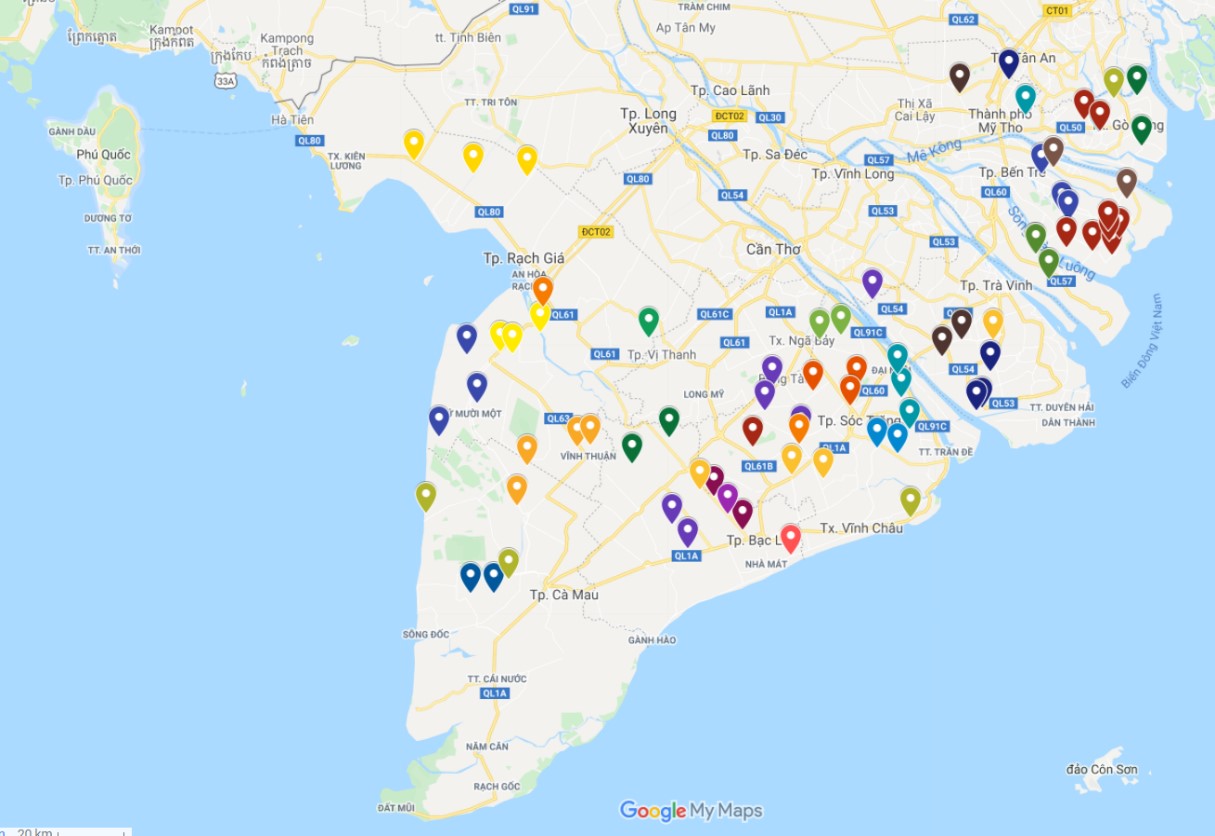11. ASSESSMENT OF LAND SUBSIDENCE DUE TO GROUNDWATER EXTRACTION IN HO CHI MINH CITY
Giới thiệu
Located in the transistion zone between highland and Mekong delta, HCM city has an average elevation of 0.0 to 2.0 m. In the Southeast, the city is boundered by the sea with a coastline of 30 km. Thus, HCM city often suffered from inundation especially in the rainy season and tide high period. Land subsidence possibly resulted from groundwater over-extraction had been doubted since some manifestations of ground surface sinking were observed at the well fields in the districts No. 6 and Binh Tan in 2004. The common way to investigate land subsidence is to construct a network of monitoring stations to record two main parameters, i.e., settlement and pore pressure change. There are a few land subsidence monitoring stations that have been installed in HCM city since 2005. However, these monitoring data have not been available for public information. Due to the lack of studies on land subsidence, there are different opinions about the causes of subsidence in HCM city. Some scientists considere that groundwater extraction is the main cause of land subsidence, while others are in favour of natural self auto-compaction of the young soft clay sediment due to construction loads. Therefore, it is necessary to understand thoroughly land subsidence due to groundwater extraction. This study, the theory and methodology to calculate land subsidence due to groundwater extraction for HCM city using 1D FEM consolidation method, the TZP computer package, based on hydrogeological and geotechnical data. Initial calculated results for the central area of HCM city with the drawdown data taken from monitoring period of 1999-2009 show that land accumulative subsidence due to groundwater extraction could be as much as 63.8 cm, 85.2 cm, and 97.6 cm for 2010, 2040, and 2100, respectively.
Toàn văn bài báo
Trích dẫn
[2]. Chan, D.N (2008). Application of modeling method to assess the storage of groundwater in HCM city. Division of Hydrogeology and Engineering Geology for the South of Vietnam (DHEGSV).
[3]. DHEGSV (2006). Hydrogeological map for HCM city on scaled of 1/100.000. Division of Hydrogeology and Engineering Geology for the South of Vietnam.
[4]. DHEGSV (2010). Compilation of geological, hydrogeological and engineering geological maps of HCMC on the scale of 1/50.000. Division of Hydrogeology and Engineering Geology for the South of Vietnam (DHEGSV), report in Vietnamese.
[5]. Dinh, H.T.M., Trung, L.V, and Toan, T.L (2015). Mapping Ground Subsidence Phenomena in Ho Chi Minh City through the Radar Interferometry Technique Using ALOS PALSAR data. Remote sensing, Pages 8543 - 8562.
[6]. Erban L. E., Gorelic, S., M, Zebker A. Z; and Fendorf, S (2013). Release of arsenic to deep groundwater in the Mekong Delta, Vietnam, linked to pumping-induced land subsidence. Proceedings of National Academy of sciences of the United States of America, vol. 110 no.34, pages 13751 - 13756.
[7]. Giao, P. H (1997). Artificial Recharge of the Bangkok Aquifer System for the Mitigation of Land Subsidence. Dissertation No. GE - 96- 2, Asian Institute of Technology (AIT), Bangkok, Thailand.
[8]. Giao, P. H., Phien-wej, N., Y. Honjo (1999). FEM quasi-3D modelling of responses to artificial recharge in the Bangkok multi aquifer system. Environmental Modelling& Software 14, 141 - 151.
[9]. Giao, P. H and Ovaskainen, E (2000). Preliminary Assement of Hanoi Land Sudsidence with Reference to groundwater Development. The Lowland Technology International, 2 (2), 17-19.
[10]. Giao, P. H., Paveechana, T., and Saowiang, K (2013). Consolidation Settlement Analysis with reference to groundwater recovery in the Bangkok Multi-aquifer system. P. 567-573, Proc. 1st Southeast Asian Geotechnical Conference cum Inaugural AGSSEA Conference, Advances in Geotechnical Infrastructure, Ed. by C. F. Leung, S. H. Goh and R. F. Shen, Research Publishing, Singapore.
[11]. HCMDNRE (2006). Land subsidence monitoring network of HCM city. Department of Natural Resources Environment of Ho Chi Minh city.
[12]. MONRE (2009). Climate change, sea level rise scenarios for Vietnam. Ministry of Natural Resources Environment.
[13]. Nga, N.V (2006). Land subsidence due to exploiting undergroundwater in the Southwest of Ho Chi Minh City. Vietnam National University-HCMC. University of Social Sciences & Humanities Magazine, Volume 36, No.12.
[14]. Nga, P.V (2008). Initial study on Land subsidence analysis due to groundwater extraction in HCM city. Master thesis No. GE-16-08. Asian Institute of Technology, Bangkok, Thailand.
[15]. Poland, J. F (1984). Guidebook to studies of subsidence due to groundwater withdrawal. Prepared for the International Hydrological Programme, Working Group 8.4, United States of America, Book Crafters, Chelsea, Michigan, ISBN 92-3-102213-X.
[16]. Terzaghi, K (1925). Simplified soil test for subgrade and their physical significance. Public Roads, v.7, p.153 - 162.





